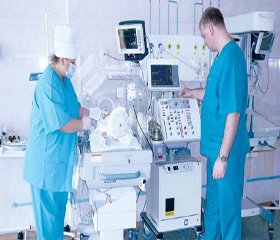Журнал «Медицина неотложных состояний» 2 (57) 2014
Вернуться к номеру
The infusion therapy characteristics in preterm newborns with respiratory distress syndrome depending on respiratory support
Авторы: Soloshenko I.V.
Рубрики: Медицина неотложных состояний
Разделы: Клинические исследования
Версия для печати
preterm newborns, respiratory distress syndrome, intensive care
Introduction. The major task of intensive therapy of preterm newborns with respiratory dysfunctions is hypoxemia and acidosis elimination and prevention, resulted in regulation of metabolism to norm, activation of surfactant production, prevention of severe hemodynamic disorders. Recent application of various types of respiratory therapy proves the significance of rapid elimination of hypoxemia in preterm newborns, as well as reduction of ventilation- associate damage of lungs.
The purpose of the research is the optimization of medical care provision to preterm newborns with respiratory distress syndrome.
Methods and materials. 125 preterm newborns have been studied. They received treatment at newborns’ intensive therapy department of Kharkiv city perinatal center during the period of 2007–2010 years. Babies were divided into following groups: the 1st group included 66 preterm newborns, undergoing ALV with normoventilaton parameters (BearCub 750 BearMedicalSystemsInc., СA, USA machine). The 2nd group included 33 preterm newborns, undergoing HFJ-respiratory support, provided by the Sensor Medics 3100А, Sensor Medics Corporation, Linda, CA, USA machine. The 3rd group (control) included 26 preterm newborns with unassisted respiration. Data analysis has been carried out using the „EXCELL FOR WINDOWS” and „STATISTICA 7.0. FOR WINDOWS” software. Considering the non-Gaussian distribution of the obtained data, indices were compared using the Mann-Whitney’s distribution-free method, evaluating the median, upper and lower quartiles, variation’s minimum and maximum values (Me [Uq, Lq], [min; max]).
Results and discussion. Baby's weight at birth did not differ: the median in babies from the 1st group was of 1650 g, from the 2nd — 1400g, and from control group — 1550 g (р1,2˃0,05, р1,3˃0,05, р2,3˃0,05). All babies who needed artificial lung ventilation had undergone Stage ІІ-ІІІ RDSN. Big variation oscillation during infusion therapy has been identified according to quartile amplitude, minimum and maximum values. Timely correction of hemodynamic disorders against the background of adequate respiratory therapy is crucial in reducing of infusion therapy and normalization of hemodynamic indices during the twenty-four hour observation period (p < 0,001).
Conclusions. Regulation of central hemodynamics to normal indices in preterm newborns with respiratory distress syndrome occurs on the second day from the beginning of intensive therapy, irrespective of the type of respiratory support.
On the second day from the beginning of intensive therapy, preterm newborns that had undergone high-frequency jet pulmonary ventilation needed less infusive therapy in comparison with newborns on the extensive artificial ventilation.

